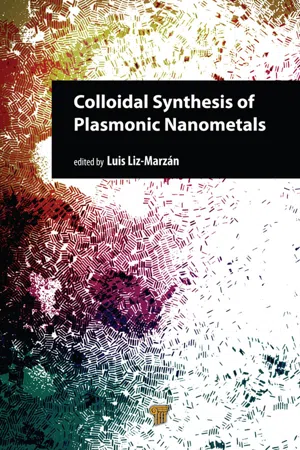
- 890 pages
- English
- ePUB (mobile friendly)
- Available on iOS & Android
Colloidal Synthesis of Plasmonic Nanometals
About this book
Noble metal nanoparticles have attracted enormous scientific and technological interest because of their unique optical properties, which are related to surface plasmon resonances. The interest in nanosized metal particles dates back to ancient societies, when metals were used in various forms as decorative elements. From the famous Lycurgus cup, made by the Romans in the 4th century AD, through thousands of stained glasses in churches and cathedrals all over medieval Europe, bright-yellow, green, or red colors have been obtained by a touch of metallic additions during glass blowing. This peculiar interaction of light with nanometals can be widely tuned through the morphology and assembly of nanoparticles, thereby expanding the range of potential applications, from energy and information storage to biomedicine, including novel diagnostic and therapeutic methods.
This book compiles recent developments that clearly illustrate the state of the art in this cutting-edge research field. It comprises different review articles written by the teams of Prof. Luis Liz-Marzán, an international leader in chemical nanotechnology who has made seminal contributions to the use of colloid chemistry methods to understand and tailor the growth of metal particles at the nanoscale. Apart from synthesis, the book also describes in detail the plasmonic properties of nanomaterials and illustrates some representative applications. This book will appeal to anyone involved in nanotechnology, nanocrystal growth, nanoplasmonics, and surface-enhanced spectroscopies.
Frequently asked questions
- Essential is ideal for learners and professionals who enjoy exploring a wide range of subjects. Access the Essential Library with 800,000+ trusted titles and best-sellers across business, personal growth, and the humanities. Includes unlimited reading time and Standard Read Aloud voice.
- Complete: Perfect for advanced learners and researchers needing full, unrestricted access. Unlock 1.4M+ books across hundreds of subjects, including academic and specialized titles. The Complete Plan also includes advanced features like Premium Read Aloud and Research Assistant.
Please note we cannot support devices running on iOS 13 and Android 7 or earlier. Learn more about using the app.
Information
Chapter 1
Nanometals: Formation and Color*
Donostia-San Sebastián, Spain
Ikerbasque, Basque Foundation for Science, 48013 Bilbao, Spain
[email protected]
1.1 Introduction
Table of contents
- Cover
- Half Title
- Title Page
- Copyright Page
- Contents
- Preface
- 1. Nanometals: Formation and Color
- 2. Gold Nanorods: Synthesis, Characterization and Applications
- 3. The Assembly of Coated Nanocrystals
- 4. Tailoring Surface Plasmons through the Morphology and Assembly of Metal Nanoparticles
- 5. Colloidal Silver Nanoplates: State of the Art and Future Challenges
- 6. Shape Control in Gold Nanoparticle Synthesis
- 7. N,N-Dimethylformamide as a Reaction Medium for Metal Nanoparticle Synthesis
- 8. Recent Progress on Silica Coating of Nanoparticles and Related Nanomaterials
- 9. Nanostars Shine Bright for You: Colloidal Synthesis, Properties and Applications of Branched Metallic Nanoparticles
- 10. Controlled Assembly of Plasmonic Colloidal Nanoparticle Clusters
- 11. From Individual to Collective Chirality in Metal Nanoparticles
- 12. Metallic Janus and Patchy Particles
- 13. Multifunctionality in Metal@Microgel Colloidal Nanocomposites
- 14. Oleylamine in Nanoparticle Synthesis
- 15. Anisotropic Noble Metal Nanocrystal Growth: The Role of Halides
- 16. The Relevance of Light in the Formation of Colloidal Metal Nanoparticles
- 17. Metal Nanoparticles and Supramolecular Macrocycles: A Tale of Synergy
- 18. Recent Approaches toward Creation of Hot Spots for SERS Detection
- 19. Increasing Complexity While Maintaining a High Degree of Symmetry in Nanocrystal Growth
- 20. Hierarchical Assembly of Plasmonic Nanoparticles
- 21. A “Tips and Tricks” Practical Guide to the Synthesis of Gold Nanorods
- 22. Design and Fabrication of Plasmonic Nanomaterials Based on Gold Nanorod Supercrystals
- 23. Growing Anisotropic Crystals at the Nanoscale
- 24. Anisotropic Metal Nanoparticles for Surface-Enhanced Raman Scattering
- 25. Silica-Coated Plasmonic Metal Nanoparticles in Action
- 26. Composite Polymer Colloids for SERS-Based Applications
- 27. Recent Advances in Chiral Plasmonics: Towards Biomedical Applications
- Index